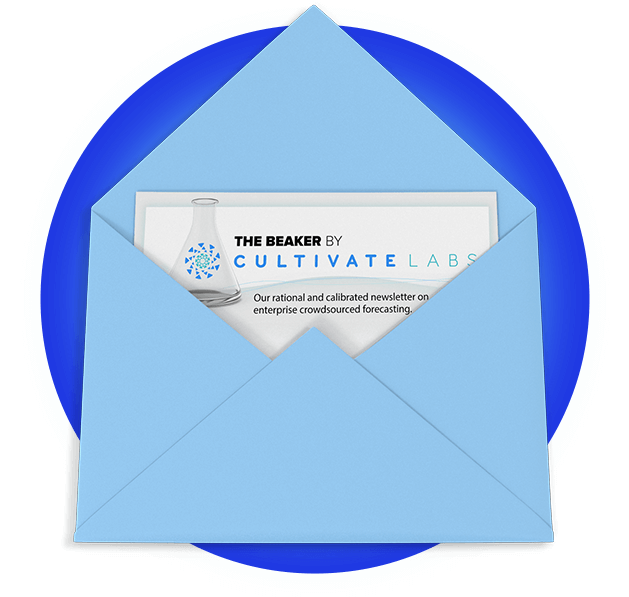Crowd Forecasting and Effective Altruism
By Henry Tolchard on November 03, 2022
I was new to working in the crowd forecasting space when I joined Cultivate Labs in December of 2021, but I had already become familiar with it through another network I’ve been involved with: effective altruism, a movement that seeks to “find the best ways to help others, and put them into practice.”
Many effective altruist (EA) core values illustrate why they are enthusiastic to use crowd forecasting methods. EAs seek to tackle problems of global significance, placing an emphasis on not only doing good, but doing good effectively. When decision-makers in government have to make high-stakes judgment calls, using rigorous forecasting techniques can improve our ability to predict the future and make better decisions, writes Benjamin Todd for the EA website 80,000 Hours.
Cultivate Labs’ forecasting programs with clients embody this theme of improving decision-making in high-impact institutions. INFER, a forecasting program co-run with the University of Maryland’s ARLIS, is designed to generate valuable signals and early warning for U.S. Government policymakers about the future of critical science and technology trends and high-risk geopolitical events. Across the Atlantic, similarly, Cultivate’s work on Cosmic Bazaar implements crowd forecasting methods across the British government, and another project with the Bertelsmann Stiftung and its Foundation, called RANGE, uses crowd forecasting to analyze geopolitics and the US-European transatlantic relationship.
Crowdsourced forecasting can help enable the type of rigorous, data-driven decision-making that EAs support in three ways.
- Forecasting leads to the quantification of uncertainty. Saying that a certain risk is “high” might be intuitive, but the difference between a 20% and an 80% risk can have drastic implications for what actions an institution should take, and forecasting requires that distinction to be made.
- Forecasters are incentivized to regularly update their beliefs over time as new information becomes available. That can improve the mental flexibility needed to confront novel challenges and help avoid being stuck in a wrong mode of thinking.
- Since the forecast questions on these platforms are verifiable, the forecasters learn how to improve their skills over time. Biases are quickly highlighted as the unfortunate truth, and subsequent hits to one’s score, burst whatever intellectual bubble was leading the forecaster astray.
By encouraging quantification, mental flexibility, and improvement over time, the wider adoption of forecasting in the offices of the most impactful decision-makers could have an extraordinary impact.
The EA community is also concerned with protecting future generations (a belief or value referred to as longtermism) by preventing the worst possible catastrophes, including risks from advanced artificial intelligence, pandemics, and nuclear war. In trying to reduce these risks while avoiding accidental harm, a clearer and more accurate view of the future is essential.
Monitoring such future risks is in line with the purpose of several of Cultivate’s client projects, particularly INFER. The topics on INFER are informed by the priorities of U.S. Government stakeholders who are interested in tracking signals and trends in these areas. For example, INFER currently has topics focused on the advancement and global impacts of AI, including the Global AI Race, U.S. Competitiveness in AI, and Microelectronic Technologies. There are also a handful of questions asking about the use and test of nuclear weapons in critical parts of the world and a new topic on synthetic biology that looks at the progress of alternatives to fossil fuels and advancements to the field more broadly.
Crowd forecasting also encourages a process of issue decomposition that provides a deeper understanding of the risks mentioned above. Using issue decomposition, a broad strategic question like “Will the United States and China compete or cooperate over the advancement of AI?” can be broken down into the pivotal factors and signals which are the drivers of the question. In visualizing the strategic question and its factors, issue decomposition can create a shared perspective EAs can use to tackle problems that otherwise might be hard to define or analyze in greater detail.
Given these shared values and goals, INFER hosted a tournament for EA student groups from universities around the world earlier this year. The response was an enthusiastic one; 11 schools competed, contributing over 1,100 forecasts on 16 different forecast questions. A couple of the best scoring participants joined the INFER Pro Forecaster team – a group of the top performing forecasters who are paid to regularly forecast on INFER – and many others continue to forecast on the platform even after the tournament ended.
While the EA community and crowd forecasting have been around for several years, both continue to learn and improve on their methods, oftentimes doing so together. We look forward to continued partnership and collaboration with members of the EA community in bringing the power of crowd forecasting to institutions seeking greater global impact. The future may depend on it.

